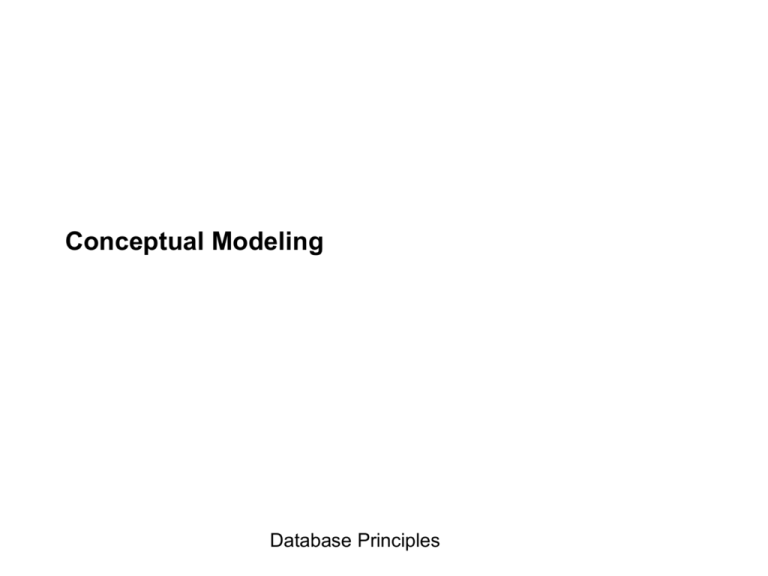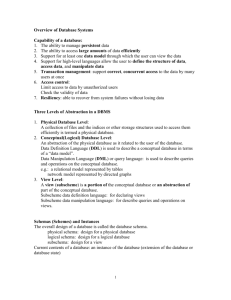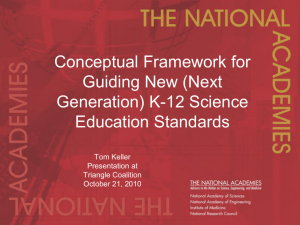1 Conceptual Modeling
advertisement

Conceptual Modeling Database Principles What is a Conceptual Model? • A mental model of the world around us • Models necessarily mean simplification/abstraction Possible Conceptual Models of “Attraction” F = GMm/R2 Database Principles Exercise: Imagine a Conceptual Model • Working in groups of three or four come up with various conceptual models for one of the following (make sure everyone contributes): Hallowe’en Christmas Buying a Cow Database Principles First Day at School Things we see in your examples: • • • • • • • Models often reflect modeler’s point of view Some models are quite specific – single detail Some models are quite general/abstract Modeling language can differ – natural, picture, song Hard if you are not familiar with the situation Not everyone in the group contributes the same Did someone lead the discussion? – Organizer vs Idea person Database Principles Hotel Example: Model a Hotel and its Operations. • Divide yourselves in groups again • Each group pick on of the following areas: – Reception (mine) – Kitchen – Room Service – Reservations – Concierge – Restaurant Database Principles Reception: • List Things of Interest: – Guest, Room, Arrival/Departure Times, Messages, Payment Method, Bill • Spread out the things and draw boxes around them • Draw Lines between related things Time: A/D Room Guest Message Bill Database Principles Payment Observations: • • • • • • • New, graphical language Lots of detail hidden or missing (how many messages?) Diagrams overlap in some places Each diagram shows only part of the big picture Synonyms? Homonyms? Not all information is modeled What happens if one department “owns” its own data? – Is it always possible? • Leader? Negotiation? Different points of view ok? • Our diagrams show areas of responsibility, a business model even!! Database Principles Summary: • Our individual views are called external views. • If we were to combine them in a single picture, negotiating synonyms and homonyms, we would have a conceptual model of a hotel business. • This conceptual model would be a first step towards a design for a database for a hotel but it is a picture of reality, not a database. • Graphical languages let us see everything at once instead of sequentially as text does. • Our language needs to be more expessive • People can be productive in teams if they have a common goal and good tools. Database Principles Formal Definitions: • A conceptual schema/model is a map of concepts and their relationships. • An external schema/view represents one person’s view of the world around her. • In the context of database, a conceptual model is the merging of various related external views. Database Principles Homework (on the web): • Read the poem “The Blind Men and the Elephant” and ... Database Principles The Blind Men and the Elephant Six wise men from India, An elephant did find. They set about to feel its parts, (For all of them were blind.) The fourth had come upon the trunk Which he did seize and shake, Quoth he, "This so-called elephant Is really just a snake." The first he felt towards the tusk, "It does to me appear, This marvel of an elephant Is very like a spear." The fifth had felt the creature's ear And fingers o're it ran, "I have the answer, never fear, The creature's like a fan." The second sensed the creature's side Extended flat and tall, "Ahah!", he cried and did conclude, "This animal's a wall." The sixth had come upon the tail As blindly he did grope, "Let my conviction now prevail, This creature's like a rope." The third had reached towards a leg And said, "It's clear to me, What we should all have said instead. This Creature's like tree." Database Principles And so these men of missing sight Each argued loud and long, Though each was partly in the right They all were in the wrong. Homework (continued): • Prepare a conceptual model of an elephant, using as your starting point, the external views expressed by each of the men in the poem. • Find out what you can about the poem and its author. • Explain how the poem relates to the task of creating a conceptual model of an organization’s information. • The poem does not introduce a “seeing” man who can set the blind men straight. Who plays the role of the seeing man in the organizational context? Database Principles Homework (continued): • One student once gave me the following answer: A fan, a spear, a wall, a rope, A snake up in a tree, Disparate views, We can not hope, Will represent reality. Why is his skepticism unlikely to be a problem in in creating a conceptual model of an organization’s information. Database Principles







